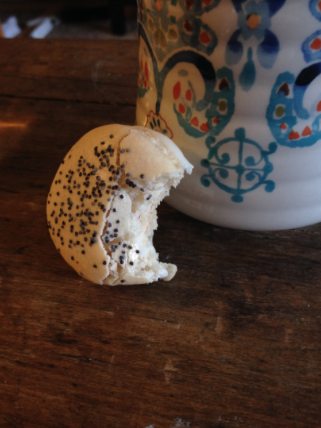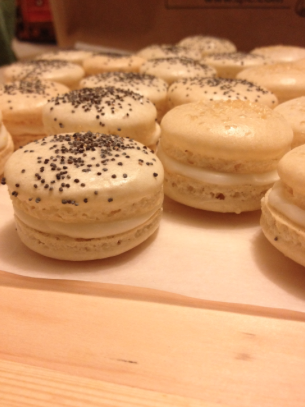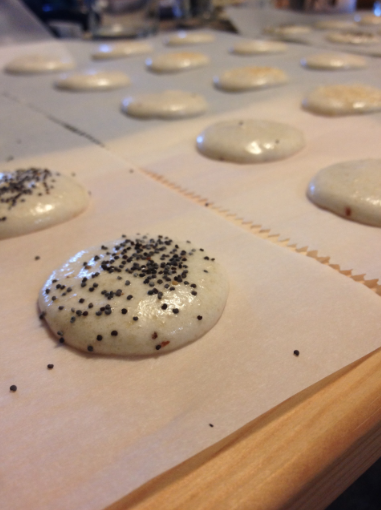Be not afraid of the world’s most notorious cookie.
For part two of my “Dessert for Breakfast” series, I made lemon poppyseed macarons. These French confections exploded in popularity around three years ago and have since been deemed passé.
Not so, says I. These little guys have been around since the 1500s, and they’re going to stick around. It helps that every single macaron I’ve ever eaten – and I’ve eaten many – has been jaw-droppingly delicious.
And jaw-droppingly expensive if you buy them at a bakery. So you might as well learn how to make them now.
The intimidation factor around macarons is high. Let me put some of your fears to rest. Remember how every macaron I’ve eaten has tasted totally awesome? That includes all of my ugly, cracked, hollow first attempts. They taste more or less the same, no matter what you do to them. All the browbeating really comes down to aesthetics and texture. Just resign yourself to the fact that your first few batches will taste, but not look, awesome.
Recipes and tips for macaron perfection abound on the web. Much of what is out there is horribly misleading and only ups the intimidation factor. When I was learning how to make macarons, I quickly aligned myself with pastry chef Stella Parks’ straightforward, no-nonsense, time-tested instructions. She does a swell job of demystifying the process and disproving the unnecessarily fussy conventional wisdom (no, you do not need to age the egg whites or bake in a zero-humidity environment, and woe betide those who demand it, because this is Seattle, goddammit). She even has an adorably encouraging post praising her readers’ weird-looking first attempts.
That said, here’s your required reading before you start my recipe. Don’t say I didn’t warn you.
The Ten Commandments of Macarons
I only diverge from her on two matters. Firstly, I can’t be bothered to calibrate my oven, so I just do a test sheet with fewer cookies on it (maybe one in the middle and one in each corner of the cookie sheet) to see how they behave. If they’re cracked or footless, I lower my oven about ten degrees. Secondly, I have a kitchen scale, but I’ m not convinced that weight measurements are quite as important as she says they are. I always measure my ingredients by weight, but inevitably spill quite a bit on the counter while I’m sifting because that’s how I roll. My macarons turn out fine. I think you could use a good old measuring cup and no one would be the wiser.
One more resource to investigate before diving in is a YouTube video of the batter folding process. It’s the only initially challenging part of making macarons, but it’s easy to master and videos help a lot. I like this one.
If yours turn out less-than-beautiful (they will at least once), some internet troubleshooting should help. Google whatever’s wrong with them (cracked, hollow, no feet) and you’ll find hundreds of sites that address it.
By the way, I buy almond meal in the Central Co-Op bulk department. Surprisingly cheap! Poppyseeds are available there as well.
Also, a word on the filling. I used a lemon buttercream with a bit of cream cheese to lessen the sweetness, which was delicious, but I realized with utter sadness after filling my last macaron that these would have had so much more lemony goodness per square inch if I had put a little dollop of lemon curd in the center. At that point I’d made two test batches and couldn’t be bothered to make a third. I suggest you include it.
Those sugar-dusted macarons up there, by the way, are gin and tonic flavored. I’ve gotten some requests for the recipe – the macarons are made just like the poppyseed ones, but topped with turbinado sugar instead of poppyseeds before baking. Don’t buy a whole bag of turbinado sugar for this – just snag a few Sugar in the Raw packets from the condiment bar next time you get coffee. Three or four should do it. You’re welcome. I love how the two flavors look together – undyed macarons with edible decorations are just as pretty as those macarons that look like they spilled from a box of crayons, albeit in a subtler way.
In any case, I’ve included the recipe for the gin and tonic buttercream. G&T macs are alcoholic, by the way, so don’t eat them for breakfast. Or do. I don’t know your life.
Lemon Poppyseed Macarons
Ingredients
For the macarons
4 oz almond meal
8 oz powdered sugar
5 oz egg whites
2.5 oz granulated sugar
1 tsp vanilla extract
1/4 tsp kosher salt
Poppyseeds
For the filling
2 oz cream cheese, softened
3 tbl butter
1 tbl lemon juice
2 tsp lemon zest
2-3 cups powered sugar
1 tsp vanilla
Pinch kosher salt
Milk or cream, to spreading consistency
Lemon curd, optional
Preheat oven to 290 degrees. Line a few cookie sheets with parchment paper. Place a large Ziploc bag inside a tall water glass, pointing a corner towards the bottom of the glass, and fold edges of bag over the edges of the glass. This will prepare the bag to be filled with batter.
Sift together almond meal and powdered sugar in a large bowl. Set aside.
Pour egg whites, granulated sugar, vanilla, and salt into a separate bowl. Using a handheld mixer with whisk attachment or a stand mixer if you have one, beat on low speed for three minutes. This is where you would normally add some gel food color if you were making colored macarons. Raise speed to medium and beat for another three minutes. Raise speed to high and beat for two minutes more. When finished, egg whites will be extremely stiff and should remain inside the whisk when it is lifted out of the bowl.
Scrape beaten egg whites into large bowl with the almond meal and powdered sugar. Using a folding and scraping method, combine ingredients until a lava-like consistency is achieved. In this step, you are essentially trying to deflate the egg whites, so you don’t have to be too gentle, but be careful to not overmix. Batter poured from a spoon should fall in a ribbon and sit atop the mixture for a while before slowly reabsorbing into the batter. From this point on, agitating or stirring the batter too much could cause it to overmix, so be gentle.
Scrape batter into the Ziploc bag, or as much as can fit, and seal top. Snip the end of the bag so there is a medium-sized hole. Pipe circles onto the cookie sheet. Size is not that important as long as they are consistent–I have made both large and small macarons, but I usually try to shoot for about an inch and a half diameter. After all macarons have been piped, rap each cookie sheet hard on the counter a few times to get rid of air bubbles and help keep macarons from cracking. Sprinkle macarons with poppyseeds. Piped macarons can sit on cookie sheets on the counter while the other macarons bake.
Bake macarons one sheet at a time for 18 minutes, or until you can cleanly remove a macaron from the cookie sheet. If the top comes off in your hand, they aren’t ready. Macarons should have a smooth, domed top and ruffly foot at the bottom. If macarons are flat, do not have feet, or have cracked, a quick Google search should help you troubleshoot – it could be that the oven temperature isn’t quite right, or the batter might have been mixed wrong. First batches are rarely perfect. Let macarons cool on the sheet, then move the parchment paper to a counter and turn each cookie over to reveal flat side.
Bake other cookie sheets in the same way until all cookies are lined up, ready to be piped.
While macarons are baking, make the buttercream. Beat butter and cream cheese together until fluffy. Add lemon juice and zest and mix. Add powdered sugar gradually, mixing until smooth. Add salt and vanilla and mix. If necessary, thin with milk or cream. Note that buttercream should be thick so it doesn’t run. Scrape buttercream into a bag and snip the end as you did for the macaron batter.
Pipe buttercream on half of the macarons, then top with the other macarons to create cookie sandwiches. If using lemon curd, pipe a small amount into the center and pipe buttercream around the outside edge of each cookie. Macarons should be stored in the refrigerator and will keep well for a few days.
Gin and Tonic Buttercream
2 oz cream cheese, softened
3 tbl butter
1 tsp lemon zest
2 tsp lime zest
2-3 cups powered sugar
1 tsp vanilla
2 shots gin
Pinch kosher salt
Mix cream cheese and butter until fluffy. Add lemon and lime zest and mix. Gradually add powdered sugar, vanilla, and salt. Gradually add gin, mixing until smooth. The goal is to get as much gin flavor into the frosting without it becoming too thin, so you may have to add more powdered sugar to achieve a thick spreading consistency.











